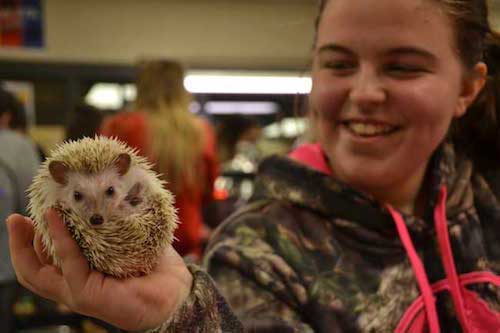FFA growing in New York faster than any other state in country
41 new FFA chapters since 2017, with total membership up 60%
Press Release, New York Department of Agriculture

Photo by Tom Rivers: Makayla Heideman, a Medina student, brought her hedgehog, Sonic, to the Medina FFA’s Animal Appreciation Day on April 26, 2018. The hedgehog is about 2 months old. This was the first time a hedgehog was part of the Medina FFA animal showcase.
New York State Agriculture Commissioner Richard A. Ball congratulated the New York FFA on its significant growth in membership since 2017, helping to further agricultural education and strengthen the State’s future workforce.
The New York FFA is a youth organization that helps middle and high school students become leaders in a variety of career fields, including agriculture. Under Governor Cuomo’s leadership, New York State dedicated nearly $5 million over the last three years to support agricultural education programs.
A record $3.6 million was invested in the 2017-18 Budget to support the New York FFA, New York Agriculture in the Classroom, and to expand the number of agriculture teachers. In November, the New York FFA received national recognition for its membership increase in the 2018-19 school year, a 60 percent increase from the previous year and the highest increase in the nation.
“It is such an exciting time for New York FFA, which is experiencing substantial growth and leading the nation in program expansion,” said Commissioner Ball. “I want to congratulate New York’s FFA members and thank its leadership for their passion and dedication to building the future of agriculture, and our Governor and Legislature for continuing to support this important program at record levels. FFA is a powerful program that helps our young people learn more about the industry and obtain the skills they need to succeed in meaningful careers in agriculture and related fields. The program is clearly a model for the nation, shining a spotlight on the many strengths of New York agriculture.”
The New York FFA currently has 7,084 members across the state, up from 4,300 in 2017. As part of the growth in young people joining the FFA, the number of new FFA chapters is also on the rise across the state. This year, the New York FFA celebrated the addition of 13 new chapters in high schools across the state, for a total of 41 new chapters added since 2017. The New York FFA is on track to meet its goal of developing 100 new chapters statewide.
FFA Educational Center Under Construction
The 2017 State Budget also included $2 million to build a state-of-the-art test kitchen and food science lab at the New York FFA Leadership Training Foundation’s Oswegatchie Educational Center in Croghan, NY.
The facility, which is currently under construction and expected to open this summer, will offer instruction in food safety, basic food preparation skills, and agricultural-related careers in food processing. It will also provide space for producers to test new processed food products. Training will be available to FFA members, agricultural educators, farm owners, beginning farmers, and other members of the public.
By educating current and future New York farmers about emerging trends in food safety, the test kitchen will serve as a valuable resource to increase participation in the New York State Grown & Certified program. In order to participate in the program, farmers must be located in New York and have food safety and environmental stewardship plans in place on their farms. More information about New York State Grown & Certified is available here.
“The 19-20 NY FFA State Officer Team set a goal at the beginning of this year to increase our membership and the number of chapters throughout the state to give students the opportunity and experiences that agricultural education and FFA can offer,” said NY FFA State President Peyton Fontaine. “We were very excited to be a part of this extraordinary achievement for New York FFA. We are working to sustain this growth by continuing to provide the resources and education to individuals that may not know about these programs. Although we have made significant progress, we still have room to grow and more students to reach!”









































































